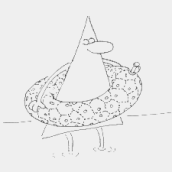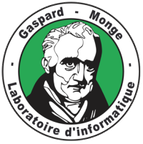Comité scientifique & Comité d’organisation
Francis Lazarus (CNRS – Université Grenoble Alpes)
Arnaud de Mesmay (CNRS – Université Paris-Est Marne-la-Vallée)
Hugo Parlier (University of Luxembourg)
Isabelle Sivignon (CNRS – Université Grenoble Alpes)
Boris Thibert (Université Grenoble Alpes)
|
Computational geometry is a rather novel field whose aim is to study the properties of geometric objects such as point clouds, arrangements, embedded graphs or triangulations: the main goal is to study their combinatorial structure and to provide efficiental gorithmic tools allowing to represent and manipulate geometric objects.
Computational geometry is a multidisciplinary domain which is at the frontier between mathematics and computer science: the members of its community take advantage of fundamental theoretical results, from several area of mathematics (for example topology, statistics, differential geometry, but also combinatorics, graph theory, numerical optimal transport and discretization of PDEs). The Journées de Géométrie Algorithmique have offered for more than two decades a friendly and informal meeting for the French Computational Geometry community and related fields (geometric modeling, combinatorics, applied topology, discrete geometry and computer graphics). It is structured as a research school and an important emphasis is placed on openness to foster communication and build bridges. This edition will feature five lectures by distinguished speakers from neighboring mathematical fields, such as calculus of variations and PDEs, machine learning, geometric aspects of data science, geometry processing and the geometry of surfaces, as well contributed talks by participants. |
La géométrie algorithmique est un domaine relativement nouveau, dont les objets d’étude principale sont les structures géométriques telles que les triangulations ou graphes plongés, les arrangements, ou encore les nuages de points. La géométrie algorithmique s’intéresse à l’étude des propriétés combinatoires de ces objets ainsi qu’à la conception d’outils algorithmiques efficaces permettant de les représenter et manipuler. De par sa nature, la géométrie algorithmique est un domaine multidisciplinaire qui se situe à la frontière entre les mathématiques et l’informatique : les membres de cette communauté font ainsi appel à des résultats théoriques fondamentaux, provenant de plusieurs domaines des mathématiques : de la topologie aux statistiques, en passant par la géométrie differentielle, la combinatoire et la théorie des graphes.
Les Journées de Géométrie Algorithmique sont un lieu de rencontre pour la communauté française de géométrie algorithmique et des domaines proches (modélisation géométrique, combinatoire, géométrie discrète, topologie appliquée et graphisme). Depuis plus de deux décennies elles ont ainsi fourni un terrain très fertile d’intéraction pour les personnes de ces domaines, qui sont pour la plupart des informaticiens et des mathématiciens. Les journées sont organisées sous la forme d’une école de recherche, avec une attention particulière à l’ouverture, pour encourager les discussions et créer des connexions. Pour cette édition, il y aura cinq cours d’ouverture par des orateurs invités de domains voisins, traitant de calcul des variations et EDP d’apprentissage, d’aspects géométriques des sciences des données, de traitement numérique de la géométrie et de géométrie des surfaces, ainsi que des présentations orales des participants. |
Nina Amenta (University of California-Davis) The space of lines in R^3 and its embeddings
Dominique Attali (CNRS Université Grenoble-Alpes) Collapsing simplicial complexes with convexity hypotheses
Evangelos Bartzos (University of Athens) Bounds on the number of embeddings of minimally rigid graphs
Laurine Bénéteau (Aix-Marseille Université) Median in median graphs and their cube complexes
Luca Castelli Aleardi (École Polytechnique) Balanced Schnyder woods for planar triangulations: applications to graph drawing and graph separators
Loïc Crombez (Université Clermont Auvergne) Hard optimization problem
Vincent Despré (LORIA) Flipping Geometric Triangulations on Hyperbolic Surfaces
Olivier Devillers (INRIA Grand-Est) Triangles fitting in the unit square fit in a triangle of area 0.6363413142
Anatole Gallouet (Université Grenoble-Alpes) Semi-discrete Generated Jacobian Equation
Leo Liberti (École Polytechnique) Distance Geometry and Data Science
André Lieutier (Dassault Systèmes Provence) Delaunay order: regular triangulations as lexicographic minimal chains and manifolds triangulation
Timothée O Donnell (INRIA Sophia Antipolis) Fréchet mean and p-mean on the unit circle: characterization, decidability, and algorithm
Hugo Parlier (University of Luxembourg) Curves on (mostly hyperbolic) surfaces
Joanny Perret (Université Grenoble-Alpes) Computing the length spectrum of a combinatorial surface
Marc Pouget (INRIA Grand-Est) Reliable Computation of the Singularities of the Projection in R3 of a Generic Surface of R4
Ivan Rasskin (Université de Montpellier) The Orthoplicial ball-packing and the ball number problem
Filippo Santambrogio (Université Claude Bernard – Lyon 1) Optimal Transport and Optimal Measures
Julien Vuillamy (INRIA Sophia-Antipolis) Lexicographic optimal homologous chains and applications to point cloud triangulations








